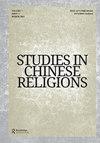中国国家图书馆近期藏藏密宗仪轨文一对开本初探
IF 0.3
3区 哲学
0 ASIAN STUDIES
引用次数: 0
摘要
摘要:本文以中国国家图书馆最近收藏的一套藏文密宗仪式典籍为研究对象,在初步翻译的基础上,探讨其藏文正字法和表达的特点,以及其中的深奥元素,特别是其中的死者仪式和制作泥板(tsha tsha),试图追溯该典籍的印度起源及其对藏文相关典籍的影响。本文章由计算机程序翻译,如有差异,请以英文原文为准。
A preliminary study on one folio of Tibetan tantric ritual text recently collected by the national library of China
ABSTRACT This article focuses on one folio of Tibetan tantric ritual text recently collected by the National Library of China, based on a tentative translation, discussing its peculiarities on Tibetan orthography and expression, its esoteric elements, especially its rituals of the dead and making clay tablet (tsha tsha), attempts to trace the Indian origin of the text and its influences on related Tibetan texts.
求助全文
通过发布文献求助,成功后即可免费获取论文全文。
去求助
来源期刊

Studies in Chinese Religions
Arts and Humanities-Religious Studies
CiteScore
0.20
自引率
0.00%
发文量
10
 求助内容:
求助内容: 应助结果提醒方式:
应助结果提醒方式:


